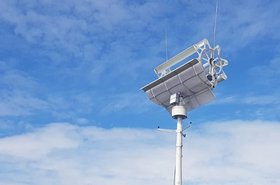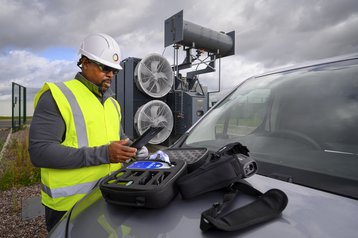Perhaps the most important consideration when designing and building a new data center is how it’s going to be powered. In the old days, it would have been pretty straightforward - you contact your regional distribution network operator (DNO), who builds any necessary infrastructure such as substations and hooks the new development up to the UK National Grid.
These days, however, the regional DNO isn’t your only option, as deregulation has led to the rise of the independent distribution network operator, or IDNO. One such business is UK Power Distribution (UKPD). DataCenter Dynamics spoke to Wendy Andrews, commercial director at parent company, Matrix Group about the advantages of working with UKPD on your build, and how it can take millions of pounds off the project budget.
To start, we asked Andrews to explain how working with an IDNO differs from registering and applying for connection via a traditional DNO: “The IDNO community needs to be different from the DNO community – we were born out of the need for competition in an industry that used to be quite serial in terms of the regional footprint each DNO covers.”
But what advantages can an IDNO offer?
“As an IDNO we've got to be able to provide a different offering to compete with the DNOs. We tend to be a bit smaller, so we're more adaptable, more flexible. But the overriding difference is that we have a real desire to offer the customer something that's more tailored to what they need, rather than be an organization that does something in a standard and typical way that they've always done.”
Andrews goes on to explain that, in an industry where regulation is essential, the freedoms offered by an IDNO actually allow for far more flexibility and cooperation between the data center operator and their infrastructure provider:
“We want to be able to deliver what the customer needs. We work in a heavily regulated industry, and the stakeholders all work around their own statutory governance, but even so, what an IDNO will do is find ways to be more customer focused. Where we really succeed is where we can engage early and be part of their team. We can do that much more readily than the DNO, which is very rigid.”
A partner at the planning stage
The key to unlocking the power of an IDNO comes from partnership, and for that relationship to blossom, early engagement in the project makes a huge difference, enabling interventions that a DNO simply can’t offer:
“We want to help a customer get the best design solution. That might be sizing the cables appropriately or making something bespoke to fit on a site, where there are space restrictions. We've got the ability to be more transparent and agile in our approach with other developers.”
Andrews goes on to illustrate specific examples of the IDNO difference:
“We can mitigate time risks, approach third party landowners and even look at early design solutions with them. We'll treat the project as tangible as the customer wants us to, whereas the DNO will treat it as an application, a point of connection application. They're not necessarily as invested at the same stage as we would be.”
Your power, your asset
But the big difference between a DNO and an IDNO is in the financial relationship between UKPD and the customer. Unlike a DNO which simply provides the necessary infrastructure, companies like UKPD recognize the asset value of any construction they are involved with and are in a position to share the wealth with the customer:
“What is fundamental is that we offer an asset value. What we are able to do is pay for the asset we adopt – we're talking about the network, the cables – and that's at a very competitive price. We can pay a consideration payment, a contribution to the construction cost. It's a sum of money that a customer wouldn't receive if they just dealt with the DNOs. A customer could be faced with a construction cost of anything up to say 20 million for its electricity infrastructure to develop a data center and the asset value could represent a seven figure sum, as cash back to help with build costs.”
In other words, using an IDNO like UKPD can significantly reduce the cost of constructing a new data center, often by a seven-figure sum – and that’s a huge lure, especially where construction is taking place on a green field site, previously untouched by the grid. However, IDNOs don’t actually generate the power. That means that for the increasing number of data center developments built around alternative power sources and micro grids, an IDNO partnership can be hugely beneficial.
“We provide value in helping the customer ensure what they want to achieve, whether it's self power, solar power, reusing energy – we can help them ensure that the site is future proof. Everybody wants a self-sufficient supply with a grid back-up, but the industry isn't there yet. Many emerging technologies are new and largely untested, unregulated, or we don't have the statistics to know that they perform as well as a grid supply that gives you as secure a connection as you can possibly get, and I think for a data center is fundamental.”
Green and safe
A conversation about power provision can’t avoid the subject of sustainability. While UKPD can’t control the green credentials of the power you use – that’s down to the grid – that doesn’t mean that it can turn a blind eye to environmental matters, and as Andrews explains, it’s a vital part of the process.
“We have a real appetite to embrace sustainability and do what we can in our part of the industry. We embrace sustainability as a policy. We look at the supply chain, at the materials we’re procuring – everything down to the real technical stuff, all to achieve our part of what sustainability is, adapting our networks to suit the customer’s sustainability needs.”
There is no margin for error when it comes to the supply of power, and so the customer needs to be sure that their infrastructure is as safe or safer than that which would be provided by the DNO. For UKPD, the policy is safety is unequivocal, as Andrews explains emphatically:
“Safety for us runs through the heart of everything we do. We’re working towards a zero incident culture. There’s a real risk of life-changing harm if you get it wrong in the electricity industry, so its fundamental to us. It’s not rocket science – if we think consistently and constantly about safety, then were more likely to work in a safe environment, and most importantly, we’ll go home safely to our friends and family at the end of the day.”
Grow your load with your business
One of the biggest advantages to a partner like UKPD is the ability to ramp your supply as the business grows. This seems obvious, but in reality, a regular DNO connection will require you to declare your maximum power load and pay for it from day one. An IDNO will allow you to use part of your load and only pay for what you need. UKPD explains it this way:
“UKPD can deliver a significant competitive advantage by offering Ramping of Capacity benefits through the Bilateral Connection Agreement (BCA) we have with the host DNO. This means that for projects that are built out over several years, the developer/ICP can secure the end game capacity for their project though the BCA. Their connections on site will be developed in accordance with their ramping profile. The rest they will only pay through their electricity bill for the incremental capacity they need over the project lifecycle."
This is because of the way that the DNO-IDNO relationship is built, as Andrews says: “The DNO can’t charge us the ramping charges, they can’t charge us and so we don't pass that on to a customer. We will only charge for the load that's used. We can add the capital contribution in the form of the asset value, but more than that – we can also help model the cost that they pay as they ramp up.”
Safety nets for maximum uptime
Uptime is vital for any data center. A truly stable connection means having back-up generators and never using them. So what does UKPD do to ensure that its infrastructure offers an always-on supply? Once again, the secret is in the partnerships that an IDNO is able to forge:
“With data centers, we can work to understand what a customer’s own safety nets such as self-generation capacity or temporary generators are, and if we need to integrate it, we do. We put the necessary custom measures in place according to need, to make sure that if there’s power, your data center is powered, and that’s as near to 100 percent as anyone can offer.”
So – you’ve built your data center. You’ve worked with UKPD from the outset and been able to reclaim a significant amount of the asset cost. Is that the end of the relationship? Andrews talks of the lifelong partnership that is forged by working with an IDNO:
“UKPD knows that once the asset is adopted, it's entirely our responsibility to maintain and operate it. There are license agreements that we've got to comply with, and it's absolutely our responsibility to do that. We need access into the site for inspections which we agree with the customer, so there's an ongoing dialogue, where sometimes a DNO is a little bit more rigid – and it goes without saying, we’re always on hand and ready to respond as needed. ”
Matrix Group operates nationwide delivering tailored energization and asset adoption services to new industrial and commercial developments. It’s a complex projects specialist with capabilities in the high voltage (HV) and extra high voltage (EHV) networks which are synonymous with the data center industry.
For more information about UKPD and Matrix Group, contact enquiries@matrixgroup.co.uk or visit www.matrixgroup.co.uk
More on UK Power Generation
-

UK data center startup offers to heat Britain's swimming pools with waste heat
Deep Green takes a deep dive starting in Exmouth, Devon
-

Don't expect nuclear power to save your data center
There are a lot of nuclear developments, but they are all in the long term future
-

Vodafone signs second solar PPA in UK
Company to procure energy from five upcoming solar farms across England

